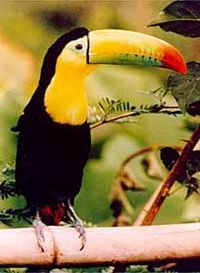|
Toucan |

Keel-billed Toucan
|
|
Scientific classification |
| Kingdom: |
Animalia
|
| Phylum: |
Chordata
|
| Class: |
Aves
|
| Order: |
Piciformes
|
| Family: |
Ramphastidae
Vigors, 1825 |
|
| Genera |
Aulacorhynchus
Pteroglossus
Baillonius
Andigena
Selenidera
Ramphastos |
Toucans are
near passerine birds from the neotropics. They are brightly marked and have enormous
colorful bills. The family includes six genera and about 40
species.
Toucans range in size from 18 to 63 cm (7 to 25 in). A
bit bigger than a crow, their body is short and thick and
the tail is rounded. The tail varies in length from half the
length to the whole length of the body. The neck is short
and thick while at the base of the head is a huge,
brightly-colored beak that measures in some large species,
more than half the length of the body. A toucan's tongue is
long, narrow, and singularly frayed on each side, adding to
its sensibility as an organ of taste.
The legs of a toucan are strong and rather short. Their
toes are arranged in pairs with the first and fourth toe
turned backward. Both males and females are the same color.
The feathers in the genus containing the largest toucans are
generally coloured black, with touches of white, yellow, and
scarlet. The underparts of the araçaris (smaller toucans)
are yellow, crossed by one or more black or red bands, and
the edges of the beak are saw-toothed. The toucanets have
mostly green plumage with blue markings.
Toucans are
frugivorous (fruit-eating), but will take insects and
other small prey such as small lizards. However, many other
birds consume these foods without the giant bill to help
them. So what is the function of the beak in feeding? One
likely use is to specialize on prey such as nestlings and
bats in treeholes. In this view, the beak is an adaptation
to allows the bird to reach deep into the treehole and
thereby access food unavailable to birds that would
otherwise compete for similar food reasources.
They are
arboreal and nest in tree holes laying 2–4 white eggs.
The young hatched are completely naked, without any down.
They are resident breeders and do not
migrate. Toucans are usually found in pairs or small
flocks.
The name of this bird group is derived from
Tupi tucana, via French.
Toucans in advertising
Toucans were used to advertise Guinness stout (using the
slogan 'See what toucan do'), and many collectables such as
postcards and models with Guinness toucans on them may be
found. Toucan Sam is the mascot of Kellogg's Froot Loops
cereal. Y107 in Nashville used a "Tookie Bird" as their mascot.
There is a European phone company called Toucan. Toucan
is part of IDT Telecom, a subsidiary of global telecoms
provider IDT Corp. They provide phone service, dial-up, and
broadband internet service as well as mobile services in the
Netherlands and the UK including Northern Ireland, Scotland,
and Wales, bringing state-of the art communications to
Europe, USA, Latin America, Africa, and Asia. They have call
centers in England, Ireland, India, and Israel.
Toucans in fiction
A humorous derivation of the name of the bird features in
David McKee's children's book "Two Can Toucan".
Wulffmorgenthaler comic strip features a character named
'Toucan kid', who is an offspring of a human and a toucan.
Tookie Tookie, George's pet Toucan from George of the Jungle.
Species list
- Aulacorhynchus
- Emerald Toucanet, Aulacorhynchus prasinus
Groove-billed Toucanet, Aulacorhynchus sulcatus
Chestnut-tipped Toucanet, Aulacorhynchus derbianus
Crimson-rumped Toucanet, Aulacorhynchus haematopygus
Yellow-browed Toucanet, Aulacorhynchus huallagae
Blue-banded Toucanet, Aulacorhynchus coeruleicinctis
-
Pteroglossus
- Lettered Aracari, Pteroglossus inscriptus
Green Aracari, Pteroglossus viridis
Red-necked Aracari, Pteroglossus bitorquatus
Ivory-billed Aracari, Pteroglossus azara
Brown-mandibled Aracari, Pteroglossus mariae
Chestnut-eared Aracari, Pteroglossus castanotis
Black-necked Aracari, Pteroglossus aracari
Collared Aracari, Pteroglossus torquatus
Fiery-billed Aracari, Pteroglossus frantzii
Stripe-billed Aracari, Pteroglossus sanguineus
Pale-mandibled Aracari, Pteroglossus erythropygius
Many-banded Aracari, Pteroglossus pluricinctus
Curl-crested Aracari, Pteroglossus beauharnaesii
- Baillonius
-
Saffron Toucanet, Baillonius bailloni
- Andigena
- Plate-billed Mountain Toucan, Andigena
laminirostris
Gray-breasted Mountain Toucan, Andigena hypoglauca
Hooded Mountain Toucan, Andigena cucullata
Black-billed Mountain Toucan, Andigena nigrirostris
- Selenidera
- Yellow-eared Toucanet, Selenidera spectabilis
Golden-collared Toucanet, Selenidera reinwardtii
Tawny-tufted Toucanet, Selenidera nattereri
Guianan Toucanet, Selenidera culik
Spot-billed Toucanet, Selenidera maculirostris
Gould's Toucanet, Selenidera gouldii
-
Ramphastos
- Keel-billed Toucan, Ramphastos sulfuratus
Choco Toucan, Ramphastos brevis
Citron-throated Toucan, Ramphastos citreolaemus
-
Channel-billed Toucan, Ramphastos vitellinus
- Yellow-ridged Toucan, Ramphastos
vitellinus culminatus
- Red-breasted Toucan, Ramphastos dicolorus
Chestnut-mandibled Toucan, Ramphastos swainsonii
Black-mandibled Toucan, Ramphastos ambiguus
-
White-throated Toucan, Ramphastos tucanus,
includes
- Red-billed Toucan, R. t. tucanus
- Cuvier's Toucan, R. t. cuvieri
-
Toco Toucan, Ramphastos toco
External links




